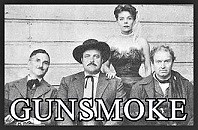
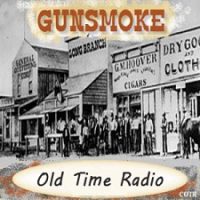 Gunsmoke (April 26, 1952–June 18, 1961) aired “The Ride Back” on June 28, 1952 as the 10th of its 480+ original episodes. This is the fifth episode of Gunsmoke we’ve showcased here, the first coming in early January of 2020, the second in June of 2020, the third in late January of 2021, with the fourth coming in October of the same year. Thus, a reprise from that initial offering of the basic history and background of this excellent radio program is in order for newcomers.
Gunsmoke (April 26, 1952–June 18, 1961) aired “The Ride Back” on June 28, 1952 as the 10th of its 480+ original episodes. This is the fifth episode of Gunsmoke we’ve showcased here, the first coming in early January of 2020, the second in June of 2020, the third in late January of 2021, with the fourth coming in October of the same year. Thus, a reprise from that initial offering of the basic history and background of this excellent radio program is in order for newcomers.
The show took place during the post-Civil War era (circa 1870) in Dodge City, Kansas during the expansion and settling of the Old West. On radio William Conrad (1920-1994, photo lower left) played Marshal Matt Dillon. On television Marshal Dillon was played by James Arness. On radio Parley Baer (1914-2002) played Dillon’s “assistant” Chester Wesley Proudfoot. On television Chester was played for the first couple of years by Dennis Weaver. On television, Chester’s last name was changed from Proudfoot to Goode. On radio Howard McNear (1905-1969) played Dr. Charles Adams. On television Doc was played by Milburn Stone. On radio Miss Kitty was played by Georgia Ellis (1917-1988, photo lower right). On television Miss Kitty was played by Amanda Blake. While the radio program ran for a solid 10 years (1952-61), the television program ran for 20 years (1955-75) and overlapped with its still airing counterpart on radio, and until programs airing after the television show’s demise, television’s Gunsmoke ranked as the longest running original live action (as opposed to animated) show of all time.
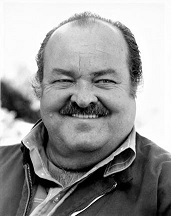
 As to the origin of Gunsmoke on radio, the story goes that in the late 1940s legendary CBS chairman William S. Paley, who was a fan of the Philip Marlowe detective series on radio, asked the head of programming to develop “a hardboiled Western” about a Marlowe of the Old West. Though an attempt was made, complications arose and the project was shelved. Enter producer Norman MacDonnell and writer John Meston a few years later, who discovered the shelved project while in the process of creating an adult Western of their own for radio (in contrast to radio westerns such as The Lone Ranger or The Cisco Kid, who were aimed primarily at a younger audience).
As to the origin of Gunsmoke on radio, the story goes that in the late 1940s legendary CBS chairman William S. Paley, who was a fan of the Philip Marlowe detective series on radio, asked the head of programming to develop “a hardboiled Western” about a Marlowe of the Old West. Though an attempt was made, complications arose and the project was shelved. Enter producer Norman MacDonnell and writer John Meston a few years later, who discovered the shelved project while in the process of creating an adult Western of their own for radio (in contrast to radio westerns such as The Lone Ranger or The Cisco Kid, who were aimed primarily at a younger audience).
Gunsmoke on radio was a critical and popular success, noted for its realism and willingness to tackle adult and/or explicit subject matter such as opium addiction, scalpings, and massacres among other adult situations and themes (Marshal Dillon, having saved a prostitute from rapists in one episode, was yet unable to dissuade her from her chosen profession). The show was not all dark and somber, however, and evolved over time into a genuinely warm and sometimes humorous “celebration of human nature.” To reinforce the realism of the excellent scripts and often times gritty subject matter, the show also rose above others due to its special effects, which brought the listener even deeper into a dusty, crowded, Dodge City, where children could be heard playing a block away, or a dog barking nearby. It was a total immersive experience for radio, and solidified the claim of the program as the first truly adult Western series on radio.
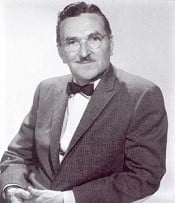
 Those familiar with the original The Andy Griffith Show (1960-68) on television will recognize the names of Parley Baer (photo at left) and Howard McNear (photo at right). They would find themselves teamed up again as they were on radio’s Gunsmoke, with Baer playing the character of Mayberry Mayor Roy Stoner, and with McNear playing Floyd the Barber. Sometime shortly after he was cast as this recurring character McNear had a stroke, almost completely paralyzing the left side of his body. He took more than a year off, but when asked by Andy Griffith to return he rejoned the cast in 1964, though camera angles and his poses had to be adjusted for. His condition deteriorated so much that after time he could no longer remember his lines. Frustrated, McNear left the show in 1967. He passed away from complications of pneumonia following another stroke on January 3, 1969. Parley Baer, his longtime friend from both Gunsmoke on radio and The Andy Griffith Show on television, read his eulogy.
Those familiar with the original The Andy Griffith Show (1960-68) on television will recognize the names of Parley Baer (photo at left) and Howard McNear (photo at right). They would find themselves teamed up again as they were on radio’s Gunsmoke, with Baer playing the character of Mayberry Mayor Roy Stoner, and with McNear playing Floyd the Barber. Sometime shortly after he was cast as this recurring character McNear had a stroke, almost completely paralyzing the left side of his body. He took more than a year off, but when asked by Andy Griffith to return he rejoned the cast in 1964, though camera angles and his poses had to be adjusted for. His condition deteriorated so much that after time he could no longer remember his lines. Frustrated, McNear left the show in 1967. He passed away from complications of pneumonia following another stroke on January 3, 1969. Parley Baer, his longtime friend from both Gunsmoke on radio and The Andy Griffith Show on television, read his eulogy.
“The Ride Back” is a relatively recent rediscovery and a worthwhile one it is. William Conrad loved the script so much it was made into a film in 1957. The screenplay was written by Antony Ellis who also wrote this radio script, and the film starred William Conrad as the Sheriff (Matt Dillon here but Chris Hamish in the film) and Anthony Quinn as the gunfighter alleged to have murdered two men, and who the Sheriff is then charged with bringing back to Dodge to stand trial. On the ride back the pair are followed by a band of Indians who have been murdering settlers, the tension rising as Marshal Dillon and his handcuffed captive must be on constant guard for they know not when the Indians will attempt to overwhelm them. At one point the two men are hold up in a small farmhouse where they discover the murdered family of a man, his wife, and their young child. In essence, at this point the story evolves further into a dramatic character study between Marshal Dillon and his captive, whose attitude darkens perceptibly following the sight of the murdered homestead family. Both characters struggle with their inner selves as they must rely on one another for their survival, their nerves becoming frayed not knowing when or how they might be attacked, and when the story reaches its unexpected denouement, a serious question surrounding the alleged murderer’s action is brought to the fore, providing a fitting conclusion to this harrowing story.
Play Time: 29:35
{“The Ride Back” aired on a Saturday evening at the end of June of 1952, less than a week before the Fourth of July. The neighborhood gang was feeling their summer vacation oats, and literally ran to the corner newsstand after changing from their Sunday’s best the next day. Action and excitement were the order of the day and they found plenty in the magazines on hand. Adventure (1910-1971) was always a solid pick, for the variety of stories within its pages always held something for every reader. Settings, themes, and pulse-pounding dangers were forever doled out in generous proportions, and a cover with a jet fighter pilot in trouble made for an exciting choice for a young male in 1952. Adventure was a bi-monthly in 1952. Planet Stories (1939-1955) was known for its wild, colorful adventure tales on other planets, and the cover below was one of its garish best, featuring the obligatory half-clad female and a Bug-Eyed Monster (BEM). Planet Stories was a bi-monthly in 1952. Startling Stories (1939-1955) was of a stripe with Planet Stories and Thrilling Wonder Stories in that imagination was All, where scientific accuracy and even logic at times took a back seat to page-turning action and colorful adventure. These magazines would publish many a story by some of the most popular, beloved genre authors in the field, and many stories in these magazines are now classics, prime examples of fiction that elusive Sense of Wonder that is hard to find these days. Startling Stories went from a bi-monthly in 1951 to a monthly in January of 1952.}
[Left: Adventure, 7/52 – Center: Planet Stories, 7/52 – Right: Startling Stories, 6/52]
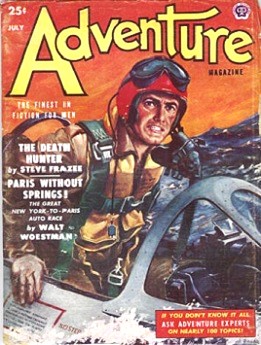
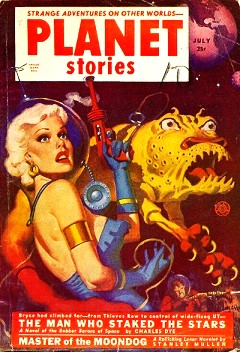
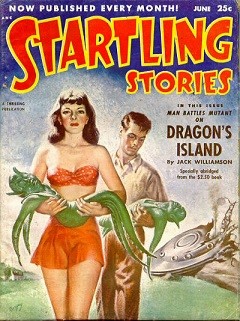
To view the entire list of weekly Old Time Radio episodes at Tangent Online, click here.